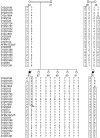Lethal congenital contractural syndrome type 2 (LCCS2) is caused by a mutation in ERBB3 (Her3), a modulator of the phosphatidylinositol-3-kinase/Akt pathway
- PMID: 17701904
- PMCID: PMC1950827
- DOI: 10.1086/520770
Lethal congenital contractural syndrome type 2 (LCCS2) is caused by a mutation in ERBB3 (Her3), a modulator of the phosphatidylinositol-3-kinase/Akt pathway
Abstract
Lethal congenital contractural syndrome type 2 (LCCS2) is an autosomal recessive neurogenic form of arthrogryposis that is associated with atrophy of the anterior horn of the spinal cord. We previously mapped LCCS2 to 6.4 Mb on chromosome 12q13 and have now narrowed the locus to 4.6 Mb. We show that the disease is caused by aberrant splicing of ERBB3, which leads to a predicted truncated protein. ERBB3 (Her3), an activator of the phosphatidylinositol-3-kinase/Akt pathway--regulating cell survival and vesicle trafficking--is essential for the generation of precursors of Schwann cells that normally accompany peripheral axons of motor neurons. Gain-of-function mutations in members of the epidermal growth-factor tyrosine kinase-receptor family have been associated with predilection to cancer. This is the first report of a human phenotype resulting from loss of function of a member of this group.
Figures




Similar articles
-
Lethal contractural syndrome type 3 (LCCS3) is caused by a mutation in PIP5K1C, which encodes PIPKI gamma of the phophatidylinsitol pathway.Am J Hum Genet. 2007 Sep;81(3):530-9. doi: 10.1086/520771. Epub 2007 Jul 24. Am J Hum Genet. 2007. PMID: 17701898 Free PMC article.
-
Homozygosity mapping of lethal congenital contractural syndrome type 2 (LCCS2) to a 6 cM interval on chromosome 12q13.Am J Med Genet A. 2004 Oct 15;130A(3):272-6. doi: 10.1002/ajmg.a.30266. Am J Med Genet A. 2004. PMID: 15378541
-
Autosomal recessive lethal congenital contractural syndrome type 4 (LCCS4) caused by a mutation in MYBPC1.Hum Mutat. 2012 Oct;33(10):1435-8. doi: 10.1002/humu.22122. Epub 2012 Jun 7. Hum Mutat. 2012. PMID: 22610851
-
Biallelic ERBB3 loss-of-function variants are associated with a novel multisystem syndrome without congenital contracture.Orphanet J Rare Dis. 2019 Nov 21;14(1):265. doi: 10.1186/s13023-019-1241-z. Orphanet J Rare Dis. 2019. PMID: 31752936 Free PMC article.
-
Human epidermal growth factor receptor 3 in head and neck squamous cell carcinomas.Head Neck. 2016 Apr;38 Suppl 1:E2412-8. doi: 10.1002/hed.24367. Epub 2016 Feb 2. Head Neck. 2016. PMID: 26835877 Review.
Cited by
-
Receptor tyrosine kinase mutations in developmental syndromes and cancer: two sides of the same coin.Hum Mol Genet. 2015 Oct 15;24(R1):R60-6. doi: 10.1093/hmg/ddv254. Epub 2015 Jul 7. Hum Mol Genet. 2015. PMID: 26152202 Free PMC article. Review.
-
Models of Distal Arthrogryposis and Lethal Congenital Contracture Syndrome.Genes (Basel). 2021 Jun 20;12(6):943. doi: 10.3390/genes12060943. Genes (Basel). 2021. PMID: 34203046 Free PMC article. Review.
-
ERBB3 mutations in cancer: biological aspects, prevalence and therapeutics.Oncogene. 2020 Jan;39(3):487-502. doi: 10.1038/s41388-019-1001-5. Epub 2019 Sep 13. Oncogene. 2020. PMID: 31519989 Review.
-
Pelizaeus-Merzbacher-like disease caused by AIMP1/p43 homozygous mutation.Am J Hum Genet. 2010 Dec 10;87(6):820-8. doi: 10.1016/j.ajhg.2010.10.016. Epub 2010 Nov 18. Am J Hum Genet. 2010. PMID: 21092922 Free PMC article.
-
Partial loss-of-function variant in neuregulin 1 identified in family with heritable peripheral neuropathy.Hum Mutat. 2022 Sep;43(9):1216-1223. doi: 10.1002/humu.24393. Epub 2022 May 17. Hum Mutat. 2022. PMID: 35485770 Free PMC article.
References
Web Resources
-
- Berkeley Drosophila Genome Project, http://www.fruitfly.org/seq_tools/splice-instrucs.html (for the Neural Networks Splice Site Prediction software)
-
- GenBank, http://www.ncbi.nlm.nih.gov/Genbank/ (forERBB3 [accession number NM_001982])
-
- InterPro, http://www.ebi.ac.uk/interpro/ (for the EMBL-EBI ERBB3 protein structure)
-
- Map Viewer, http://www.ncbi.nlm.nih.gov/mapview (for build 36)
References
-
- Gissen P, Johnson CA, Morgan NV, Stapelbroek JM, Forshew T, Cooper WN, McKiernan PJ, Klomp LW, Morris AA, Wraith JE, et al (2004) Mutations in VPS33B, encoding a regulator of SNARE-dependent membrane fusion, cause arthrogryposis-renal dysfunction-cholestasis (ARC) syndrome. Nat Genet 36:400–40410.1038/ng1325 - DOI - PubMed
Publication types
MeSH terms
Substances
Associated data
- Actions
LinkOut - more resources
Full Text Sources
Molecular Biology Databases
Research Materials
Miscellaneous

